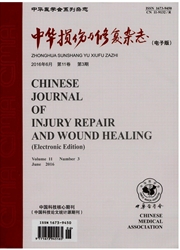

 中文摘要:
中文摘要:
目的:我们利用经美国FDA批准成为临床使用材料的聚己内酯为主要原料,发明了一种可吸收的形状记忆聚合物,添加的辅料偶联剂为烃氧基硅烷;多官能团单体选自含2个到3个烯键的有机酯,如季戊四醇三烯酸酯等;填料选用含有活性钙离子的化合物,如磷酸氢钙等,均为生物相容性良好,且可吸收的材料(专利号:200610023175)。通过体外细胞学实验,对该生物降解可吸收记忆聚合物的生物相容性进行评价。方法:实验采用3T3细胞进行原代及传代培养,然后将细胞接种到两组载体上一生物降解可吸收记忆聚合物组和裸皿培养组。建立不同的3T3细胞培养系统。利用绘制细胞生长曲线、MTT比色及3H-胸腺嘧啶(3H.TdR)掺入方法观察体外培养3T3细胞在生物降解可吸收记忆聚合物载体上的活力、增殖及DNA合成情况,研究生物降解可吸收记忆聚合物载体的生物相容性。结果:在生物降解可吸收记忆聚合物和裸皿中培养时,3T3细胞的活力、增殖和代谢等生物学特性无明显差别。结论:体外细胞学实验表明这种生物降解可吸收记忆聚合物具有良好的生物相容性。
 英文摘要:
英文摘要:
ABSTRACT Objective: The main material is the absorbable shape-memory polymer invented by us with polycaprolactone, approved to use in clinic by U. S. FDA. The coupling agent that the si-or is added as the accessories. A multiple functional group is organic ester with two or three ethylenic linkages, such as pentaerythritol, triacrylate etc. Filling materials are the compounds with the active calcium ions, such as calcium hydrophosphate etc, which are quite biocompatible and absorbable. (Patent Number: 200610023175.) This thesis is aimed at evaluating the biological compatibility of the carrier of the absorbable and biodegradable shape-memory polymer by the cytological experiments in vitro. Methods: In the assay, the 3T3 cells were cultured in primary and passage cultures. Cells were inoculated to two groups of carrier that the absorbable and biodegradable memory polymer group and naked dish group, which built different 3T3 cell culture system. The activity, proliferation and DNA synthesis of in vitro culture 3T3 cells were observed to study the polymer carrier biocompatibility, when the cells were inoculated to the biodegradable shape-memory polymer carrier, by the cell growth curve, MTT, 3H-TdR assay. Results: There is little difference of effect on the activity, proliferation and metabolism etc. biological characteristics of in vitro culture 3T3 cells that were cultured the absorbable and biodegradable shape-memory polymer and naked dish. Conclusions: The vitro cells assay indicates that this absorbable and biodegradable shape-memory polymer has good biocompatibility. Key words: Biodegradable shape-memory polymers; 3T3; Biocompatibility
 同期刊论文项目
同期刊论文项目
 同项目期刊论文
同项目期刊论文
 Antibacterial properties and bioactivity of HACC- and HACC–Zein- modified mesoporous bioactive glass
Antibacterial properties and bioactivity of HACC- and HACC–Zein- modified mesoporous bioactive glass Selective laser sintering fabrication of nano-hydroxyapatite/poly-epsilon-caprolactone scaffolds for
Selective laser sintering fabrication of nano-hydroxyapatite/poly-epsilon-caprolactone scaffolds for 期刊信息
期刊信息
